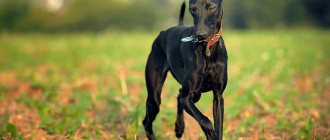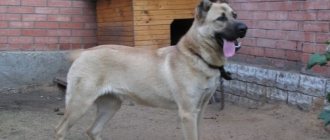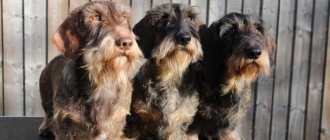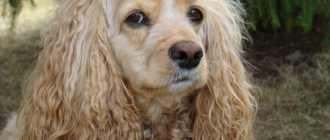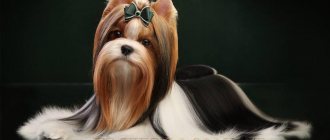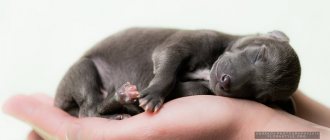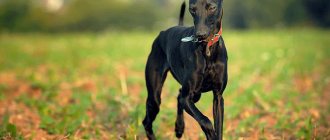Italian Greyhounds or Italian Greyhounds are known for their lightning-quick reflexes and playful nature, but they also happen to be some of the most adorable couch potatoes. If there's a warm lap for them to lie on, that's where you'll find them.
Italian Greyhounds are miniature versions of greyhounds. They share the same habits of greyhounds to a lesser extent, making them more manageable for new dog owners or those who gravitate toward smaller dog breeds.
Characteristics of the Italian Greyhound
| Attachment level | High |
| Friendliness | High |
| Child Friendly | High |
| Loyalty to other pets | High |
| Exercise needs | Average |
| Playfulness | High |
| Energy level | Average |
| Learning ability | Average |
| Intelligence | Average |
| Tendency to bark | Average |
| Shedding amount | Average |
| Attention needs | High |
| Weather tolerance | Low |
Italian greyhound dog - description of the breed
This is a representative of the greyhound family, and the shortest. This is what it is like - this Italian greyhound, the description of the breed says that it is mobile, one might even say swift and is ready at any moment to break loose and rush after prey. If during a hunt it could be some small animal - a mouse, a hare or a squirrel, then in the “concrete jungle” a dog can chase a package thrown by the wind, so when walking it is worth taking into account this instinct of pursuit that they have.
Italian Greyhound is ideal for active people: young couples or mature people with older children. Older people can also take a closer look at this breed, especially if they still feel the strength to be active. Italian greyhounds have a weak sense of smell, but they see very well and are well oriented in space. In unfamiliar surroundings they behave restlessly, growling and barking.
Many people are interested in the question of how long Italian Greyhounds live; with proper care, they reach the age of 15 years without losing good physical shape. It is necessary to take into account the breed’s temperament, difficult character and gushing energy, but the main thing is to provide the pet with love and attention, and then he will respond to care a hundredfold.
What does an Italian Greyhound look like?
This is a typical greyhound with an arched back, lean body and muscular long legs. The Italian greyhound's ears hang freely down the sides of the head, and the coat is short. Her slender body fits into a square, the length is almost equal to the height at the withers. The Italian greyhound breed was stabilized only in the 20-30s of the last century. Before this, it risked completely disappearing due to crossing with closely related forms within the same population and excessive refining.
The typical Italian Greyhound, as a model of grace, was obtained and established by crossing with the Whippet to preserve the Greyhound type and the Miniature Pinscher to enhance the small stature. As a result, we got a fragile and graceful breed, the length of the head of which reaches 40% of the height at the withers. However, such a slender physique makes her vulnerable and prone to injury. Dogs often suffer broken limbs.
History of the Italian Greyhound breed
The ancestors of the Italian greyhound are greyhounds, which were bred by the pharaohs of Ancient Egypt. From here the breed began to spread, first across Greece and then Italy. Italian Greyhound is a dog breed that was very popular in Ancient Rome. During the Renaissance, every rich Italian considered it his duty to keep such a dog, pampering it in every possible way and worshiping it as a deity.
It is known that many reigning persons kept Italian greyhounds: the British Queen Victoria, the Russian Empress Catherine II, and the King of Prussia, Frederick the Great, did not want to part with the dog even during the war, when he was forced to hide from enemy troops under a bridge. If the dog had barked, they would have been discovered immediately, but the animal did not make a sound. Frederick loved and revered his pet so much that he buried him in the burial place of royalty.
Italian greyhound - character
A breed such as the Italian Greyhound has taken a lot from its ancestor. Like any greyhound, she is very active, but is not inclined to objectively assess her physical capabilities, which results in unpleasant consequences for her - falls and injuries, so the owner should restrain her impulses. However, daily walks, outdoor games and running are extremely necessary for her, so you cannot deprive your dog of such pleasure.
She is careful, but at the same time she is very friendly towards people, especially children, she happily fools around with them, jumps and has fun. Due to their age, children may not understand how fragile these dogs are, which is why they are recommended to be owned by couples with already independent and smart offspring. The Italian Greyhound is prone to restless behavior, can tremble in an unfamiliar situation, and tactile contact with the owner is very important to them, so endless “hugs” await him.
Italian Greyhound – colors
A dog's fur can come in a variety of colors. Italian Greyhound is a breed of dog, the description of which gives clear indications in this regard. Uneven color is more likely to indicate disqualifying faults, although small light areas under the throat and on the paws are quite acceptable. The basic types of colors are:
- grey
; - beige
; - black
; - brown
.
History of the Italian Greyhound
The Italian Greyhound breed is believed to have originated in the Mediterranean lands known today as Greece and Turkey over 2,000 years ago.
Artifacts from this site contain images of this breed, and miniature skeletons of them were discovered during archaeological excavations. Dogs were probably kept around for several reasons - for companionship and hunting small game.
Italian Greyhounds moved to southern Europe during the Middle Ages and became quite popular lap dogs, especially for the aristocrats of Italy. It was there that the Italian Greyhound got its name.
Renaissance portraits of aristocrats often depicted their furry companions. James I, Frederick the Great, Catherine the Great, Anne of Denmark and Queen Victoria were just a few famous owners of this breed.
The American Kennel Club registered the first Italian Greyhound in 1886, marking the beginning of the breed's popularity in the United States. The First and Second World Wars almost destroyed the Italian greyhound population, but it was American breeders who brought this greyhound breed back to life.
Character and features
The main character traits of the Italian Italian greyhound are tenderness, affection and kindness. She can adapt to the temperament of any person, his lifestyle. You can raise a puppy, as they say, to suit yourself. In a sporty family, an Italian greyhound will happily run around the park. Together with homebodies or elderly owners - bask on the sofa.
At the same time, it is very easy to spoil her; all you need to do is show weakness once by indulging the dog. This is especially true for families with children. Italian Greyhounds love to play with babies, but you should immediately impress upon the dog that the child is also the master and must be obeyed.
The Italian Greyhound is sensitive to the mood of others, so it is better not to take it into a house where frequent quarrels occur. Dogs are extremely sensitive, have a hard time dealing with conflicts from their owners, and can get sick in such an atmosphere. Italian Greyhounds are frightened by loud screams and begin to rush around the house in horror. They quickly become attached to a person, suffering from separation from him, so it is not advisable to have such a pet for people who disappear all day at work. The Italian Greyhound is extremely curious, likes to climb higher (for example, on a cabinet or the back of a chair) in order to watch what is happening from above.
The Italian Greyhound is not afraid of heights and can fall out of a window!
Because of their exceptional grace and habits, Italian greyhounds are often called cat-dogs; Italians get along well with them. Italian greyhounds also treat representatives of their own breed very well, but are extremely wary of others. It is not advisable to keep them together with large dogs, since small ones can easily get injured. It is better if Italian Greyhounds live with animals of similar character. Such as Papillon or Biewer York. Do not forget that these are hunting dogs - they will attack small animals (for example, hamsters). Otherwise, they are quite friendly and unpretentious.
Italian Greyhound Care
Despite their seemingly cool disposition and napping habit, Italian Greyhounds need regular exercise to stay healthy.
Daily walks and obedience training are necessary, spending time playing may just be their favorite activity besides sitting on your lap. These dogs are extremely playful, so an active game of fetch or a fun puzzle toy will help release their energy.
Owners of Italian Greyhounds should be aware of the breed's high hunting instinct when visiting off-leash dog parks. Small animals can lead your pet on a chase, even if he is professionally trained to stay by your side.
Positive, reward-based training is the best option for most dog breeds. Trainers must be firm as this breed can be stubborn or absent-minded. Small treats should always be given in exchange for tricks. Punishment training simply won't work with this sensitive breed.
Caring for an Italian Greyhound does not require much commitment from owners. Because they have short hair, they only need occasional baths and brushing as needed.
Their teeth should be brushed daily to prevent excessive tartar buildup, and their nails should be trimmed regularly. Those who are not experienced in trimming dog nails should visit a professional groomer or veterinarian to learn how to do the job.
Dog owners should examine their pet for rashes and other skin irritations during grooming. Rashes can be a sign of allergies.
Maintenance and care
Italian Greyhounds are domestic dogs; they love warmth and comfort. They can be kept both in a private house and in a small apartment. After buying a puppy, you need to arrange a cozy soft place for it, preferably in the form of a house with a roof. Although these dogs prefer to sleep on the bed or climb higher and watch everyone.
The puppy will also need a lot of toys. These dogs love balls, rubber squeakers, and soft plush toys. You also need to buy a leash, preferably a tape measure, which gives the dog the opportunity to run. Choose a soft collar according to size. It is also important to immediately purchase clothes: warm and waterproof overalls, blouses.
Walk
Although this is a decorative dog, it is still a greyhound. Therefore, she needs physical activity and daily walking 2-3 times a day. Although she can be toilet trained in a diaper and taken outside once. But while walking she has to run around. To do this, it is better to go to a dog park or take your pet out into nature. Italian greyhounds have such strong hunting instincts that the dog can catch and bring back a hare or rodent without training.
But in the city you cannot let a greyhound off its leash. Even an obedient dog can run away after chasing a pigeon. In such cases, Italian greyhounds get very carried away and do not hear the owner’s commands. Also, representatives of this breed love to pick up food from the ground, this also needs to be monitored.
In the cold season, Italian Greyhounds require clothing to walk. Short hair without undercoat does not protect them from bad weather at all. Although dogs themselves do not like to walk in the rain or frost, they would rather lie at home in the warmth.
Hygiene procedures
Caring for these dogs is simple; following the basic rules will help keep your pet healthy. An Italian greyhound should be taught hygiene procedures from an early age:
- It is enough to comb short hair once a week with a brush or silicone mitt;
- during the molting period, it is better to collect hair with a brush daily, although these dogs shed very little of it;
- bathe 2-3 times a month, use shampoo for short-haired dogs;
- After each walk, wash your paws and inspect the pads for cracks;
- wipe eyes as needed with warm boiled water;
- check and clean ears once a week with veterinary lotion;
- It is also recommended to brush your pet’s teeth every week to prevent plaque from accumulating;
- The claws of such dogs usually do not grind down on their own; they will have to be trimmed with a nail clipper and sharpened with a special nail file.
Nutrition
Italian Greyhounds love to eat, often beg for food and pick it up on the street. But they are not picky about food and eat everything. Therefore, you need to monitor the amount of food so that the dog does not gain weight. An adult Italian greyhound needs to be fed 1-2 times a day. Choose a feeding method that is convenient for the owner. This can be dry food or natural products, you just can’t mix them.
When feeding naturally, the bulk of the diet should be lean meat. It can be turkey, veal, rabbit, beef tripe, stringy pieces, cartilage. A couple of times a week, meat can be replaced with boneless sea fish.
Additionally, the dog’s diet includes porridge, raw and boiled vegetables, vegetable oil, kefir, and cottage cheese. You can give apples, cheese, and crackers as treats. With this method of feeding, it is necessary to give your pet vitamin and mineral supplements.
It is easier to ensure a balanced diet and determine the amount of food when feeding dry food. It is important to choose premium or super-premium food that contains all the nutrients the animal needs.
Health
Italian Greyhounds' health is quite good; there are almost no hereditary diseases. With proper care and suitable housing conditions, they live up to 15-16 years, remaining active. To do this, you need to regularly visit the veterinarian, undergo vaccination and deworming. Due to their body type, these dogs have fragile bones, so fractures often occur, especially in puppyhood. It is necessary to protect children from jumping and falling from heights.
Representatives of the breed are also prone to several other pathologies:
- Perthes disease;
- retinal atrophy;
- glaucoma, cataract;
- periodontitis, tartar;
- allergy;
- alopecia;
- dermatitis;
- epilepsy.
What do Italian Greyhounds get sick of?
If you are purchasing a puppy, always make sure that you are purchasing from a reputable breeder. Breeders must perform health checks before offering any puppy for sale and provide buyers with a health certificate for each puppy. Overall, Italian Greyhounds are healthy dogs with a long lifespan of 13 to 15 years.
Italian Greyhound Diseases You Should Know About:
- Allergy
- Cataracts and other eye problems
- Hypotoroidism
- Hip dysplasia
- Patella dislocation
Diseases
Italian greyhounds do not have any special health problems. Their life expectancy is from 12 to 16 years. They get sick mainly because their fur is too short. In addition, they often receive serious injuries; for example, they can break a leg when jumping from a height.
Other possible health problems include:
- periodontal disease;
- glaucoma;
- dermatitis;
- retinal atrophy;
- baldness;
- allergy;
- corneal dystrophy;
- cataract;
- epilepsy.
Often in Italian greyhounds there is a deviation such as incomplete descent of the seed (cryptorchidism). The pathology can only be treated surgically, but does not pose a danger to the animal. Such dogs are excluded from breeding.
For prevention, you must be vaccinated against:
- rabies;
- plague;
- leptospirosis;
- parainfluenza;
- hepatitis A;
- parvovirus enteritis.
The first vaccinations are given at eight weeks, after two weeks they are revaccinated and vaccinated against rabies (the procedure is repeated a year). Italian Greyhounds, due to their small amount of subcutaneous fat, are very sensitive to anesthesia - this must be taken into account.
How and what to feed Italian Greyhounds
It is important to choose healthy food for your pet, regardless of breed. Italian Greyhounds generally do not have any special dietary needs and require a quality, balanced dog food.
Some owners choose to feed their IGS a diet of raw food, while others prefer kibble. Either way, talk to your veterinarian to make sure your puppy is getting all the minerals and vitamins he needs to live a long, healthy life.
Italian Greyhounds are eager eaters, so they will happily gobble up treats. To maintain their weight, give treats infrequently and make sure they don't get too much food. It is very important to prevent obesity in Italian Greyhounds, as their thin bones are not designed to carry excess weight.
Make sure your pet is getting the right amount of calories for his size, and consult your veterinarian if you have any questions or concerns about his weight.
Appearance - color and size
The Italian Greyhound is rightfully considered one of the most graceful and elegant dogs. The height of the Italian greyhound at the withers is from 33 to 38 cm, weight - from 3.5 to 5 kg. Males are slightly larger than females, but the gender differences are very slight. At first glance, the dog looks emaciated, but it is very muscular and can reach speeds of up to 40 km per hour. The Italian Greyhound's back is straight, with a rounded loin and a narrow, but rather powerful chest (with a height at the withers of 35 cm, its circumference should be at least 41 cm). The Italian inherited this type of body structure from her greyhound ancestors.
A purebred Small Italian Greyhound must meet the following requirements:
- The head should be narrow and long, like that of larger greyhound breeds.
- The eyes are large and dark in color. There are black rims on the eyelids. The look is intelligent, lively, devoted.
- The nose is preferably black, but brown is also acceptable.
- The jaw is slightly elongated, with the lips tightly pressed.
- The teeth are small, white, incisors are in one line.
- The limbs are long, thin with developed muscles. The pads are oval with tightly closed toes.
- The claws are dark.
- The ears are small and spread to the sides. In a wary state, they turn forward. During the period of breeding work, terrier genes appeared in the ancestors of the modern Italian greyhound in the form of erect ears. Now this is considered a marriage.
- The tail is thin, long, and curves upward.
The coat of Italian greyhounds is very short, smooth, without undercoat. Soft and velvety to the touch, equal length throughout the body.
The following colors are acceptable:
- white;
- lilac;
- all shades of red;
- black;
- pale yellow;
- grey;
- sand;
- blue;
- cream;
- piebald.
Brindle and black and tan are considered a match!
During the time of the pharaohs, Italian greyhounds lived in palaces. She could have become capricious and spoiled, but this did not happen. The Italian Greyhound is valued for its loyalty to its owner and lively intelligence.
Where to buy an Italian Greyhound puppy, Italian greyhound
Be especially careful when purchasing a purebred Italian Greyhound puppy. For example, avoid brindle puppies, as brindle coloring is not possible in purebreds. If you buy a so-called Italian Greyhound with this pattern, then it is not a purebred and you should not overpay.
You can buy an Italian greyhound puppy on our website
As with any puppy purchase from a breeder, you should ask for a health certificate and ask to see the puppy's mother to ensure he is healthy and being treated well. Although it can be difficult to find an Italian Greyhound in a shelter, it is possible. Check your local shelters regularly to find this rare breed.
Training
The Italian greyhound is not a dog that lovers of training should own. She is capable of learning as long as the classes are interesting to her. However, the simplest skills can be mastered quite easily. The main thing is to start training and socializing the puppy as early as possible. It is very important to immediately accustom your baby to walks in open spaces and the company of other dogs, otherwise she will be terrified of the street, loud sounds, and will become nervous and unsociable.
The Italian Greyhound must follow basic commands:
- place. You should strictly pronounce the word, then immediately take the puppy to the designated territory;
- ugh;
- sit is a command that is taught from 2 months. To do this, you need to raise the treat above the animal’s head while pronouncing the word. The puppy will sit down involuntarily.
- lie down - act in the same way as in the previous case, only lower the bait down;
- show your teeth;
- to me, etc.
You cannot shout at an Italian greyhound, much less hit it. You need to act exclusively with the help of praise and encouragement, but strictly.
Other Breeds to Study
Before you decide to get an Italian Greyhound, study their character and habits, talk to other breed owners and reputable breeders to learn more.
If you're interested in similar breeds, check out their profiles to compare the pros and cons:
Greyhound (English greyhound)
Whippet
Afghan Hound
Saluki
There are many breeds of dogs, with careful research you can find a pet that suits you and bring it into your home.
How to choose a puppy
First of all, before purchasing, you need to decide on the breed. For example, when choosing between a Chihuahua and an Italian greyhound, it is worth considering that both dogs are delicate and fragile. Sneezes more often have congenital diseases, but need walks less than Italian greyhounds. If you still choose an Italian, you should think about whether she will participate in exhibitions or just need a companion dog. An exhibition specimen is much more expensive due to its exterior, but to a non-professional, Italian pet-class greyhounds look no worse.
The main thing is to choose a healthy individual. It is worth paying attention to the following parameters:
- a two-month-old puppy should have six teeth on top and bottom;
- the tail is straight, without bends;
- acceptable color;
- There should be no umbilical hernia.
A small greyhound should be active. It is especially good if she herself goes into the arms of a potential owner and strives to start a game.
Dogs that look like Italian greyhounds
This is the whippet already mentioned, which was used to preserve the greyhound type. The Italian greyhound is a more refined and gentle creature, and its progenitor is larger, moreover, with excellent watchdog qualities; it is not for nothing that it is called the “bull terrier among greyhounds.” The English Greyhound is also very similar to the dog breed described in this article.
However, she has a strong build, well-developed muscles, a deep chest, and strong hind legs. This is an excellent short-distance runner, capable of catching up with a hare. Those interested in how much an Italian greyhound costs, can be answered that for a puppy from an international champion you will have to pay up to $1.2 thousand, and an animal without documents from a marriage can be bought for $70-150.
Nutrition
The main factor in a pet dog’s health is its nutrition. An animal's diet can be either artificial or natural. But, if you give him food from your table, then make sure that it is not on the list of prohibited foods for him.
Let's start with the main thing. The Italian Greyhound should not be given:
- Stale or expired food.
- Any sweets, especially quiches.
- Sauerkraut.
- Meat fried in sunflower oil.
- Fatty foods - lard, stewed meat, pork lungs.
- Fast food.
- Lollipops.
- Raw potatoes.
Eating this type of food will have a negative impact on your Italian Greyhound's health. She is a picky eater and will eat whatever you give her. Therefore, the dog’s health is primarily the responsibility of its owner.
What is recommended to give to the Italian Greyhound? The best and safest option is dry food. For representatives of this breed, there is a special food for sale for Italian greyhounds, which contains not only vitamins, but also useful microelements, for example, calcium and zinc. But, if you still want to feed your pet natural food, check out what may be on his menu:
- Buckwheat or rice porridge with boiled or raw meat.
- Mashed potatoes.
- Soup with bone cartilage.
- Raw fruits and vegetables.
- Cottage cheese or cottage cheese casserole.
- Borscht with meat.
- Stewed meat products.
- High-quality semi-finished products.
- Ground meat.
- Lean fish.
Pros and cons of the breed
If you decide to buy an Italian Greyhound puppy, consider whether you can provide the extremely active dog with sufficient exercise and regular walks. Such a pet requires a lot of attention and care from the owner. To make the right decision, it is worth familiarizing yourself with the strengths and weaknesses of the Italian breed.
Pros:
1. Easy to care for and not expensive to maintain. 2. Suitable for apartment maintenance. 3. Friendly character, loyalty. 4. Gets along well with other miniature dogs. 5. Easily tolerates moving and traveling.
Price
The Italian Greyhound is not a cheap breed. High-breed dogs from kennels cost from 35-40 thousand rubles. And if the dog has a good pedigree, then its cost can reach up to 50 thousand rubles.
The price of an Italian greyhound without documents and a veterinary passport is from 19 to 25 thousand rubles. We recommend buying an animal from a nursery, but if you still decide to use the services of a breeder, do not forget to first research his reputation.
Note ! Advertisements for the sale of Italian greyhounds that list a negotiated price often contain deception. Breeders are trying to pass off cute mongrels with lean bellies as noble Italian greyhounds.
